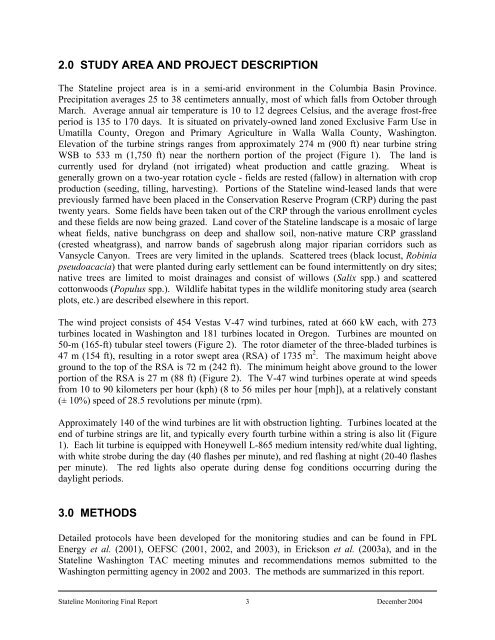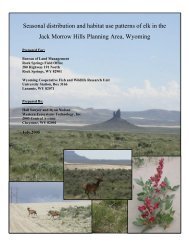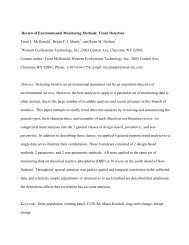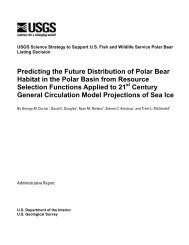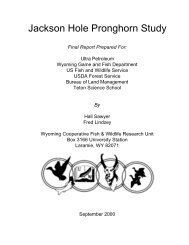Stateline Wind Project Wildlife Monitoring Final Report - WEST, Inc.
Stateline Wind Project Wildlife Monitoring Final Report - WEST, Inc.
Stateline Wind Project Wildlife Monitoring Final Report - WEST, Inc.
You also want an ePaper? Increase the reach of your titles
YUMPU automatically turns print PDFs into web optimized ePapers that Google loves.
2.0 STUDY AREA AND PROJECT DESCRIPTION<br />
The <strong>Stateline</strong> project area is in a semi-arid environment in the Columbia Basin Province.<br />
Precipitation averages 25 to 38 centimeters annually, most of which falls from October through<br />
March. Average annual air temperature is 10 to 12 degrees Celsius, and the average frost-free<br />
period is 135 to 170 days. It is situated on privately-owned land zoned Exclusive Farm Use in<br />
Umatilla County, Oregon and Primary Agriculture in Walla Walla County, Washington.<br />
Elevation of the turbine strings ranges from approximately 274 m (900 ft) near turbine string<br />
WSB to 533 m (1,750 ft) near the northern portion of the project (Figure 1). The land is<br />
currently used for dryland (not irrigated) wheat production and cattle grazing. Wheat is<br />
generally grown on a two-year rotation cycle - fields are rested (fallow) in alternation with crop<br />
production (seeding, tilling, harvesting). Portions of the <strong>Stateline</strong> wind-leased lands that were<br />
previously farmed have been placed in the Conservation Reserve Program (CRP) during the past<br />
twenty years. Some fields have been taken out of the CRP through the various enrollment cycles<br />
and these fields are now being grazed. Land cover of the <strong>Stateline</strong> landscape is a mosaic of large<br />
wheat fields, native bunchgrass on deep and shallow soil, non-native mature CRP grassland<br />
(crested wheatgrass), and narrow bands of sagebrush along major riparian corridors such as<br />
Vansycle Canyon. Trees are very limited in the uplands. Scattered trees (black locust, Robinia<br />
pseudoacacia) that were planted during early settlement can be found intermittently on dry sites;<br />
native trees are limited to moist drainages and consist of willows (Salix spp.) and scattered<br />
cottonwoods (Populus spp.). <strong>Wildlife</strong> habitat types in the wildlife monitoring study area (search<br />
plots, etc.) are described elsewhere in this report.<br />
The wind project consists of 454 Vestas V-47 wind turbines, rated at 660 kW each, with 273<br />
turbines located in Washington and 181 turbines located in Oregon. Turbines are mounted on<br />
50-m (165-ft) tubular steel towers (Figure 2). The rotor diameter of the three-bladed turbines is<br />
47 m (154 ft), resulting in a rotor swept area (RSA) of 1735 m 2 . The maximum height above<br />
ground to the top of the RSA is 72 m (242 ft). The minimum height above ground to the lower<br />
portion of the RSA is 27 m (88 ft) (Figure 2). The V-47 wind turbines operate at wind speeds<br />
from 10 to 90 kilometers per hour (kph) (8 to 56 miles per hour [mph]), at a relatively constant<br />
(± 10%) speed of 28.5 revolutions per minute (rpm).<br />
Approximately 140 of the wind turbines are lit with obstruction lighting. Turbines located at the<br />
end of turbine strings are lit, and typically every fourth turbine within a string is also lit (Figure<br />
1). Each lit turbine is equipped with Honeywell L-865 medium intensity red/white dual lighting,<br />
with white strobe during the day (40 flashes per minute), and red flashing at night (20-40 flashes<br />
per minute). The red lights also operate during dense fog conditions occurring during the<br />
daylight periods.<br />
3.0 METHODS<br />
Detailed protocols have been developed for the monitoring studies and can be found in FPL<br />
Energy et al. (2001), OEFSC (2001, 2002, and 2003), in Erickson et al. (2003a), and in the<br />
<strong>Stateline</strong> Washington TAC meeting minutes and recommendations memos submitted to the<br />
Washington permitting agency in 2002 and 2003. The methods are summarized in this report.<br />
<strong>Stateline</strong> <strong>Monitoring</strong> <strong>Final</strong> <strong>Report</strong> 3<br />
December 2004


